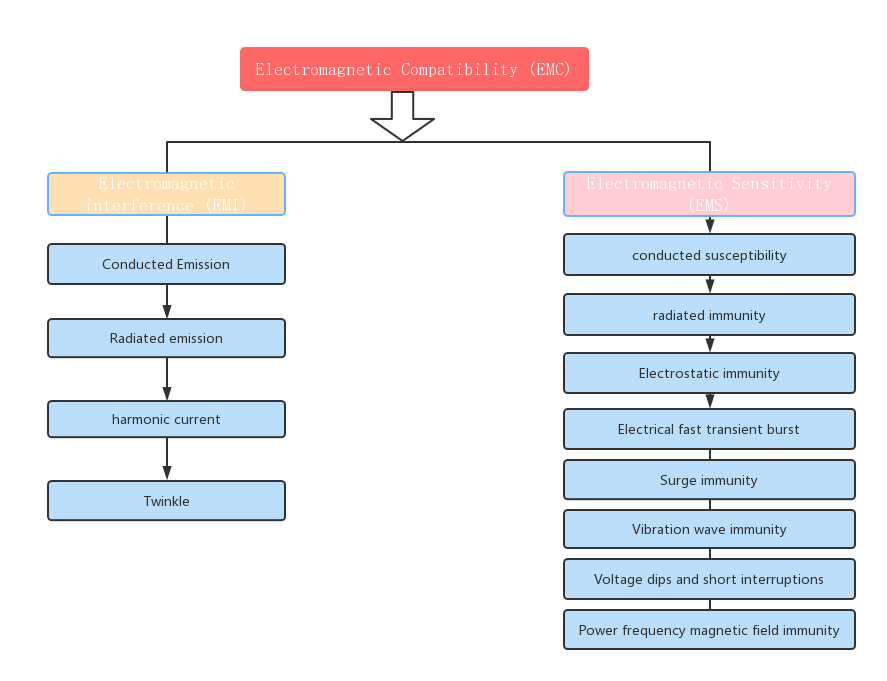The purpose of conducting an electromagnetic compatibility (EMC) test is to assess the level of electromagnetic radiation released from the equipment. The test is designed to determine the potential for interference and to evaluate the equipment's ability to withstand interference emitted by other electronic and electrical equipment.Testing helps brands comply with the EU Electromagnetic Compatibility directive, which refers to the ability of a device or system to operate within its electromagnetic environment and not to cause unbearable electromagnetic harassment to any device in its environment.Therefore, EMC includes two requirements: on the one hand, it means that the electromagnetic disturbance (Electromagnetic Disturbance) caused by the equipment to the environment during normal operation can not exceed certain limits; On the other hand, it means that the equipment has a certain degree of immunity to electromagnetic disturbance in the environment, i.e. electromagnetic susceptibility (EMS).
二、Scope of EMC Directive 2014/30/EU:
EMC Directive 2014/30/EU Includes Electrical and Electronic Equipment, Systems:
Home radio and television receivers
Industrial Manufacturing Equipment
Action radio
Mobile Radio and Commercial Mobile Phone
Medical and scientific equipment
Information Technology Equipment
General and household appliances
Air and Marine Wireless Equipment
Electronic equipment for Education
Telecommunication network and instruments
Radio and TV transmitters
Lighting and fluorescent lamps
EMC electromagnetic compatibility includes EMI (interference) and EMS (susceptibility), i.e. EMI and EMI. Simply put: EMI+EMS=EMC (as shown)

三、EMC Certification Process
1. Enterprise submits application form;
2. Technical data submission: including product manual, installation and maintenance manual, circuit schematic diagram, list of key parts, nameplate design, CE certificate or conformity statement DoC of main purchased parts, etc;
3. Sample testing (testing in accordance with relevant harmonized standards of EMC Directive)
4. Issue test report and EMC certificate, and affix CE mark;
The purpose of conducting an electromagnetic compatibility (EMC) test is to assess the level of electromagnetic radiation released from the equipment. The test is designed to determine the potential for interference and to evaluate the equipment's ability to withstand interference emitted by other electronic and electrical equipment.Testing helps brands comply with the EU Electromagnetic Compatibility directive, which refers to the ability of a device or system to operate within its electromagnetic environment and not to cause unbearable electromagnetic harassment to any device in its environment.Therefore, EMC includes two requirements: on the one hand, it means that the electromagnetic disturbance (Electromagnetic Disturbance) caused by the equipment to the environment during normal operation can not exceed certain limits; On the other hand, it means that the equipment has a certain degree of immunity to electromagnetic disturbance in the environment, i.e. electromagnetic susceptibility (EMS).
二、Scope of EMC Directive 2014/30/EU:
EMC Directive 2014/30/EU Includes Electrical and Electronic Equipment, Systems:
Home radio and television receivers
Industrial Manufacturing Equipment
Action radio
Mobile Radio and Commercial Mobile Phone
Medical and scientific equipment
Information Technology Equipment
General and household appliances
Air and Marine Wireless Equipment
Electronic equipment for Education
Telecommunication network and instruments
Radio and TV transmitters
Lighting and fluorescent lamps
EMC electromagnetic compatibility includes EMI (interference) and EMS (susceptibility), i.e. EMI and EMI. Simply put: EMI+EMS=EMC (as shown)

三、EMC Certification Process
1. Enterprise submits application form;
2. Technical data submission: including product manual, installation and maintenance manual, circuit schematic diagram, list of key parts, nameplate design, CE certificate or conformity statement DoC of main purchased parts, etc;
3. Sample testing (testing in accordance with relevant harmonized standards of EMC Directive)
4. Issue test report and EMC certificate, and affix CE mark;